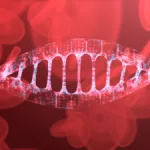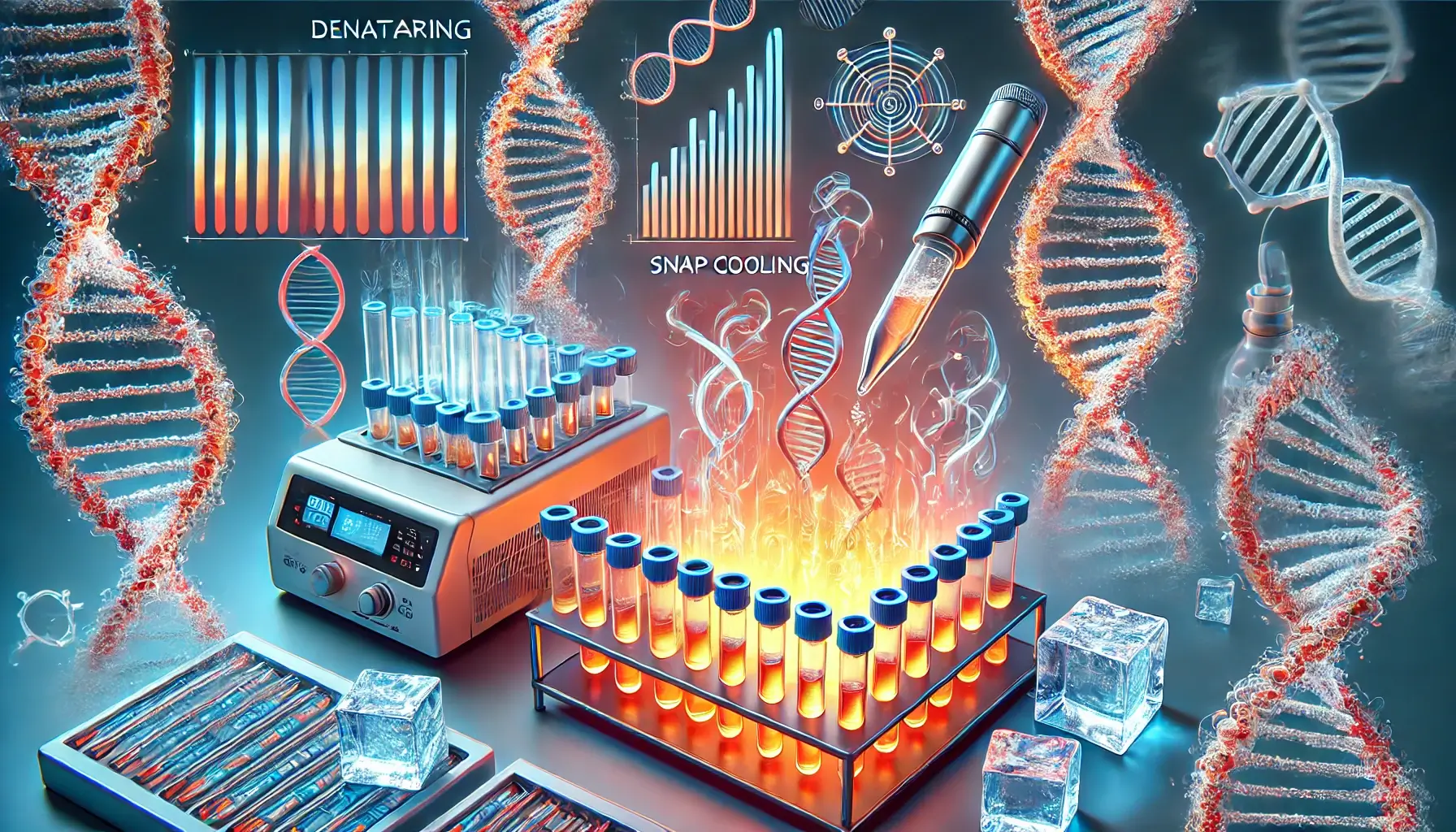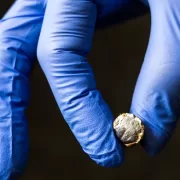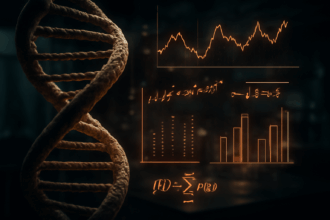Capillary electrophoresis (CE) has become a cornerstone technique in modern molecular biology and genetic analysis. This powerful method allows for the separation and analysis of DNA DNA, or Deoxyribonucleic Acid, is the genetic material found in cells, composed of a double helix structure. It serves as the genetic blueprint for all living organisms. Read Full Definition fragments with remarkable precision. However, to achieve optimal results, proper sample preparation is crucial. Two key steps in this preparation are denaturing and snap cooling PCR products, which play a vital role in ensuring accurate and high-resolution separations during capillary electrophoresis.
DNA, or Deoxyribonucleic Acid, is the genetic material found in cells, composed of a double helix structure. It serves as the genetic blueprint for all living organisms. Read Full Definition fragments with remarkable precision. However, to achieve optimal results, proper sample preparation is crucial. Two key steps in this preparation are denaturing and snap cooling PCR products, which play a vital role in ensuring accurate and high-resolution separations during capillary electrophoresis.
- The Importance of DNA Denaturation in Capillary Electrophoresis
- The Role of Snap Cooling in Sample Preparation
- Impact of Resolution and Accuracy of CE Results
- How Denaturation Affects Peak Resolution
- Influence on DNA Sizing Accuracy
- Reducing artifacts and anomalies
- Challenges and Considerations in CE
- Best Practices for Denaturing and Snap Cooling PCR Products
- Optimal denaturation temperatures and times
- Recommended snap cooling methods
- Troubleshooting common issues
- Conclusion: The Role of Denaturing and Snap Cooling in Enhancing Capillary Electrophoresis
Understanding the importance of DNA denaturation and snap cooling is essential for researchers and lab technicians working with CE. This article explores why these steps are critical, how they impact the resolution and accuracyIn scientific and measurement contexts, "accuracy" refers to the degree of proximity or closeness between a measured value and the true or actual value of the measured quantity. Accuracy indicates how well a measurement reflects Read Full Definition of results, and the best practices to implement in your lab. We’ll also dive into the science behind DNA denaturation and the role of snap cooling in sample preparation, providing you with the knowledge to enhance your capillary electrophoresis experiments.
In This Article:
- The Importance of DNA Denaturation in Capillary Electrophoresis
- The Role of Snap Cooling in Sample Preparation
- Impact of Resolution and Accuracy of CE Results
- Best Practices for Denaturing and Snap Cooling PCR Products
- Conclusion: The Role of Denaturing and Snap Cooling in Enhancing Capillary Electrophoresis
The Importance of DNA Denaturation in Capillary Electrophoresis
What is DNA Denaturation?
DNA denaturation is a process that separates double-stranded DNA (dsDNA) into single strands (ssDNA). This occurs when the hydrogen bonds between complementary base pairs are disrupted, causing the double helix
During denaturation, the compact structure of the double helix breaks down, and the DNA strands adopt a random arrangement. This process significantly impacts the DNA’s properties, which can be observed through changes in its UV light absorption. In its native state, DNA absorbs less UV light than separate polynucleotide chains, a phenomenon known as hypochromicity. As denaturation occurs, there’s an increase in UV light absorption at 260 nm, called the hyperchromic effect.
Why is DNA Denaturation Necessary for CE?
DNA denaturation is crucial for capillary electrophoresis (CE) because it enhances the accuracy and resolution of DNA fragment separation. Here’s why it’s so important:
- Improved Separation: Denatured ssDNA migrates through the polymer matrix based on its size, allowing for more precise"Precise" refers to the degree of closeness or consistency between multiple measurements or values taken under the same conditions. It indicates how well these measurements agree with each other, regardless of whether they are accurate Read Full Definition separation of DNA fragments.
- Suppression of Secondary Structures: Denaturation helps suppress the formation of secondary structures in DNA strands that could affect their mobility and, consequently, their calculated size.
- Enhanced Precision: Denaturation, often performed under high temperatures (around 60°C), is essential for high-precision and high-resolution sizing operations in CE (Oto, 2001).
- Consistent Migration: Denatured DNA fragments have a more uniform shape, leading to more consistent migration through the capillary.
- Better Resolution: The process allows for the separation of DNA fragments that differ by as little as a single base pair, which is critical in applications such as mutation detection. The presence of denaturants and operation at elevated temperatures (e.g., 60°C) are mandatory for achieving high-resolution and precise sizing of DNA fragments (Wenz et al., 1998).
Techniques for DNA Denaturation
Several methods can be used to denature DNA for capillary electrophoresis:
- Heat Denaturation: Elevated temperatures (typically around 95°C) disrupt the hydrogen bonds holding DNA strands together. This is often the first step in PCR and is widely used in CE.
- Chemical Denaturants: Chemicals like formamide and urea are commonly used in CE. These substances weaken the hydrogen bonds between base pairs, promoting strand separation.
- pH Changes: Alterations in pH levels can also lead to DNA strand separation. For instance, alkaline conditions can denature DNA.
- Combination Methods: Often, a combination of heat and chemical denaturants is used in CE to ensure complete denaturation. For example, using heat (60°C) along with formamide and urea in the polymer matrix is known to yield high-precision results.
In CE, the choice of denaturation method can impact the quality of results. For instance, using a combination of heat (60°C) and chemical denaturants (like formamide and urea) in the polymer matrix has been shown to give high-precision and high-resolution sizing operations.
It’s worth noting that the effectiveness of denaturation can be monitored by observing changes in UV absorption at 260 nm. The temperature at which half of the DNA is denatured is known as the melting temperature (Tm), which varies depending on factors like the DNA’s GC content and the surrounding conditions.
The Role of Snap Cooling in Sample Preparation
What is Snap Cooling?
Snap cooling is a crucial step in the sample preparation process for capillary electrophoresis (CE). It involves rapidly cooling a heated DNA sample by placing it on ice immediately after denaturation. This quick temperature change helps maintain the single-stranded form of the DNA, which is essential for accurate CE analysis.
Benefits of Snap Cooling for CE Analysis
Snap cooling offers several advantages for CE analysis:
- Reduced Primer-ssDNA Constructs: Snap cooling decreases the percentage of primer-ssDNA constructs, leading to cleaner results and more accurate fragment sizing.
- Prevents Re-Annealing: The rapid cooling prevents DNA strands from re-annealing, ensuring that the sample remains in its denatured state. This is essential because reannealing of dsDNA can interfere with the separation process in CE, leading to inaccurate results (Casanova et al., 1990).
- Enhanced Resolution: By maintaining the ssDNA, snap cooling allows for better separation of DNA fragments, resulting in improved resolution and more precise size determination.
- Improved Separation Performance: Snap cooling contributes to the reproducibility and reliability of CE by ensuring that the DNA fragments remain single-stranded throughout the analysis. This is particularly important for applications such as mutation detection and SNP genotyping, where precise separation of homoduplexes and heteroduplexes is required (Li et al., 2002).
- Facilitation of Trans-Cleavage: In some molecular biology applications, such as CRISPR-Cas12a, snap cooling can create single-stranded “defects” in dsDNA, serving as potential cleavage sites. This can be beneficial for certain molecular biology techniques that rely on DNA manipulation.
Mechanism of Snap Cooling
To achieve optimal results in CE analysis, it’s important to follow proper snap cooling techniques:
- Heat Denaturation: First, heat the DNA sample to 95°C for 5 minutes to ensure complete denaturation.
- Immediate Cooling: After heating, transfer the sample immediately to an ice bath or a pre-chilled cooling block to halt re-annealing.
- Formamide Addition: In many CE protocols, formamide is added to the sample before or after snap cooling to stabilize the ssDNA and prevent re-annealing. Formamide is known to significantly lower the melting temperature (Tm) of DNA:DNA and RNA:DNA duplexes, which helps in maintaining the ssDNA state by preventing re-annealing. This is particularly useful in CE protocols where maintaining ssDNA is crucial for accurate analysis (Casey & Davidson, 1977).
- Avoid slow cooling: It’s important to note that slow cooling at room temperature, as suggested in some original protocols, may not be as effective as snap cooling for maintaining DNA in its denatured state.
- Consider sample composition: The effectiveness of snap cooling can vary depending on the DNA sample’s composition and the specific CE application. It may be necessary to optimize the cooling time and temperature for different types of samples.
The rapid transition from high to low temperature stabilizes the DNA in its single-stranded form, essential for achieving high-resolution separation during CE.
Impact of Resolution and Accuracy of CE Results
How Denaturation Affects Peak Resolution
Denaturation significantly impacts peak resolution in CE. Fully denatured DNA has a uniform structure that ensures consistent migration through the capillary, leading to sharper and more well-defined peaks. The use of denaturants like urea and formamide, combined with elevated temperatures, helps suppress secondary structures, allowing for accurate DNA sizing.
Influence on DNA Sizing Accuracy
Inaccurate denaturation can lead to secondary structures or partial re-annealing, which may cause anomalous migration patterns and inaccurate DNA sizing. The use of denaturing agents such as urea and 2-pyrrolidinone, combined with increased capillary temperatures, enhances the accuracy and precision of ssDNA sizing in CE. These conditions help mitigate sequence-specific anomalous migration, thus improving the reliability of DNA fragment analysis (Rosenblum et al., 1997).The combination of chemical and thermal denaturation often yields the best results in terms of accuracy and precision.
Reducing artifacts and anomalies
Proper denaturation plays a crucial role in reducing artifacts and anomalies in CE results. Incomplete denaturation can lead to the formation of artificial species during sample preparation or electrophoresis, interfering with the accuracy of the method. For example, in reduced capillary electrophoresis sodium dodecyl sulfate (rCE-SDS) analysis of monoclonal antibodies, incomplete reduction can result in the formation of fragments like HL and HH, which may be mistakenly classified as product-related impurities. These artificial impurities can be minimized by optimizing incubation time and temperature during sample denaturing.
In some cases, artifacts may appear as unknown peaks between expected fragments. These can be challenging to eliminate through regular method optimization. However, by enhancing capillary separation temperature and adjusting separation voltage, it’s possible to reduce or eliminate these artifacts, leading to more accurate purity evaluation and impurity analysis.
Challenges and Considerations in CE
- Sample Preparation: Proper purification and desalting of PCR products are crucial for high-quality results. Automated systems and commercial clean-up kits are available to streamline this process, ensuring high-quality results (Thomas et al., 2004).
- Automation and Throughput: Advances in CE technology, such as capillary array electrophoresis, have increased the throughput and automation of DNA analysis, making it a viable option for high-throughput sequencing and mutation screening (Righetti et al., 2002).
- Artifacts and Anomalies: Incomplete denaturation can cause artifacts in CE results, leading to inaccurate analyses. The potential for artifacts and allelic drop-outs necessitates careful optimization of denaturation conditions and sample preparation (Rosenblum et al., 1997). This may include adjusting buffer pH, denaturing temperature, incubation time, and SDS concentration. By carefully optimizing these parameters, researchers can minimize artifacts and anomalies, leading to more accurate and reproducible CE results.
Best Practices for Denaturing and Snap Cooling PCR Products
Optimal denaturation temperatures and times
To achieve the best results in capillary electrophoresis, it’s crucial to optimize the denaturation process for PCR products. The initial denaturation step is typically performed at 94–98°C for 1–3 minutes. This step has a significant impact on separating the double-stranded template DNA into single strands, allowing primers to bind to the target region and initiate extension.
The time and temperature for denaturation can vary depending on the nature of the template DNA and buffer salt concentrations. For instance, mammalian genomic DNA might require longer incubation periods than plasmids and PCR products due to its complexity and size. DNA with high GC content (>65%) often needs longer incubation or higher temperature for effective denaturation.
After the initial denaturation, subsequent PCR cycles typically begin with a separate denaturation step lasting 0.5–2 minutes at 94–98°C. It’s important to optimize these parameters based on the specific characteristics of your template DNA, DNA polymerase, and buffer components.
Recommended snap cooling methods
Snap cooling is an essential step in preparing PCR products for capillary electrophoresis. This process helps maintain the DNA in its single-stranded form, which is crucial for accurate analysis. Here’s a recommended method for snap cooling:
- Heat the DNA sample to 95°C for 5 minutes to ensure complete denaturation.
- Immediately transfer the sample to an ice bath or a pre-chilled cooling block.
- Allow the sample to cool on ice for approximately 3-10 minutes.
This rapid temperature change is vital for preventing the re-annealing of DNA strands. Some protocols suggest adding formamide to the sample before or after the snap cooling process, as it helps stabilize single-stranded DNA and further prevents re-annealing.
Troubleshooting common issues
When working with Polymerase Chain reaction products in capillary electrophoresis, you might encounter several issues. Here are some common problems and potential solutions:
- Low signal strength: If PCR products are visible on an agarose gel but not on the CE instrument, the issue might be with the fluorescently labeled primer. In this case, consider optimizing the PCR reaction by increasing template, primer concentration, or the number of cycles.
- Uneven amplification in multiplex reactions: If one PCR product shows low signal in a multiplex reaction, try increasing the primer-pair concentration for that specific target. Alternatively, consider amplifying problematic primer pairs separately.
- Missing larger peaks in the size standard: This can cause sizing analysis to fail. It might be sample-related, where smaller ions and PCR products are preferentially injected into the capillaries. To address this, adjust the injection conditions or dilute the sample.
- No visible bands on agarose gel: This could indicate issues with the PCR reaction itself. Review your PCR protocol, check reagent quality, and ensure proper cycling conditions.
- Differences in fluorescent dye performance: Be aware that different fluorescent labels may require different loading amounts. For example, NED™-labeled samples might need higher loading compared to 6-FAM™-labeled samples to achieve comparable signal strength.
By following these best practices and troubleshooting tips, you can enhance the quality and reliability of your capillary electrophoresis results when working with PCR products.
Conclusion: The Role of Denaturing and Snap Cooling in Enhancing Capillary Electrophoresis
Denaturing and snap cooling PCR products are essential steps in ensuring accurate and reliable results in capillary electrophoresis. By converting double-stranded DNA into single strands, denaturation improves the resolution of DNA fragment separation, enabling the detection of mutations and polymorphisms. Snap cooling further stabilizes the single-stranded DNA, ensuring that the DNA fragments are properly prepared for analysis. By following best practices in sample preparation, researchers can enhance peak resolution, improve sizing accuracy, and reduce artifacts, leading to more reliable data Information in analog or digital form that can be transmitted or processed. Read Full Definition.
Information in analog or digital form that can be transmitted or processed. Read Full Definition.
To wrap up, mastering the techniques of DNA denaturation and snap cooling is crucial to get the most out of capillary electrophoresis. These steps, while seemingly simple, play a vital role in shaping the outcome of genetic analyzes. As the field of molecular biology continues to evolve, the importance of these fundamental processes in ensuring accurate and reproducible results cannot be overstated.
FAQs:
What is the role of DNA denaturation and snap cooling in capillary electrophoresis?
DNA denaturation and snap cooling are crucial steps in capillary electrophoresis. DNA denaturation separates double-stranded DNA into single strands, which enhances the accuracy and resolution of DNA fragment separation. Snap cooling rapidly cools a heated DNA sample, maintaining the DNA in its single-stranded form, which is essential for accurate analysis.
What are the benefits of snap cooling in capillary electrophoresis analysis?
What are the benefits of snap cooling in capillary electrophoresis analysis?
Snap cooling offers several advantages for capillary electrophoresis analysis. It reduces primer-ssDNA constructs, improves denaturation, enhances resolution, and facilitates trans-cleavage in certain molecular biology techniques. It ensures that the DNA remains in its denatured state, which is crucial for accurate analysis.
How does denaturation affect the peak resolution and DNA sizing accuracy in capillary electrophoresis?
Proper denaturation has a significant impact on peak resolution and DNA sizing accuracy in capillary electrophoresis. When DNA is fully denatured, it adopts a more uniform shape, allowing for more consistent migration through the capillary, leading to sharper peaks and improved resolution. The accuracy of DNA sizing is heavily influenced by the denaturation process, with incomplete denaturation leading to inaccurate size estimates.
What are the best practices for denaturing and snap cooling PCR products for capillary electrophoresis?
The best practices include optimizing the denaturation process for PCR products, typically performed at 94–98°C for 1–3 minutes. Snap cooling involves heating the DNA sample to 95°C for 5 minutes, immediately transferring the sample to an ice bath or a pre-chilled cooling block, and allowing the sample to cool on ice for approximately 3-10 minutes.
How can optimizing the denaturation and snap cooling process improve the accuracy of your capillary electrophoresis results, and what challenges have you faced in perfecting these steps in your lab?











